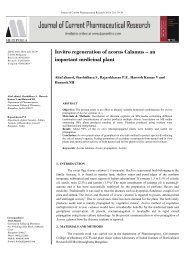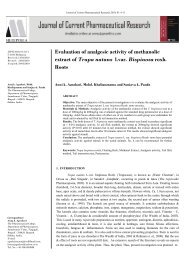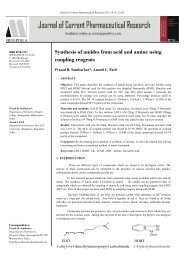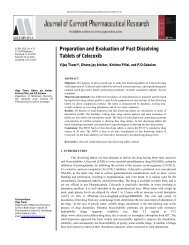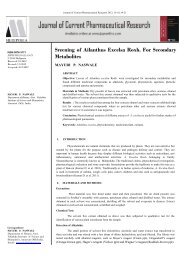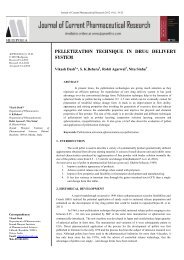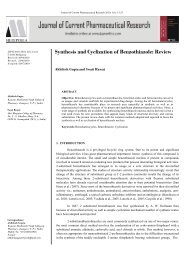Download PDF - Journal of Current Pharmaceutical Research
Download PDF - Journal of Current Pharmaceutical Research
Download PDF - Journal of Current Pharmaceutical Research
Create successful ePaper yourself
Turn your PDF publications into a flip-book with our unique Google optimized e-Paper software.
<strong>Journal</strong> <strong>of</strong> <strong>Current</strong> <strong>Pharmaceutical</strong> <strong>Research</strong> 2012; 9 (1): 49-54<br />
JCPR 2012; 9 (1): 49-54<br />
© 2010 Medipoeia<br />
Received 19-4-2012<br />
Revised: 21-4-2012<br />
Accepted: 23-4-2012<br />
Development and validation <strong>of</strong> UV/Visible spectroscopic<br />
method for estimation <strong>of</strong> new NSAID, Zaltopr<strong>of</strong>en in tablet<br />
dosage form<br />
Aher K. B. * , Bhavar G. B., Joshi H. P.<br />
ABSTRACT<br />
Aher K. B. * Bhavar G. B.<br />
Department <strong>of</strong> Pharmaceutics,<br />
Amrutvahini College <strong>of</strong> Pharmacy,<br />
Amrutnagar, Sangamner – 422 608,<br />
Maharashtra, India<br />
Joshi H. P.<br />
Formulation development Department,<br />
IPDO, Dr. Reddy’s Laboratory,<br />
Hyderabad, Andhra Pradesh, India<br />
Objective: A simple, rapid, precise, and economical spectrophotometric method has been developed<br />
for quantitative analysis <strong>of</strong> Zaltopr<strong>of</strong>en (ZLT) in pharmaceutical formulations.<br />
Materials & Methods: The method is developed using methanol as a solvent. The stock solution <strong>of</strong><br />
ZLT was prepared in methanol and subsequent dilution was done in methanol. The standard solution<br />
<strong>of</strong> ZLT showed two absorption maxima, one at 228.5 nm and another at 330.0 nm.<br />
Results: The drug obeyed Beer–Lambert’s law in the concentration range <strong>of</strong> 1–40 μg/mL with<br />
regression 0.9995 at 228.5 nm and 2–100 μg/mL with regression 0.9998 at 330.0 nm. The overall %<br />
recovery was found to be 99.71% and 100.07% at 228.5 nm and 330.0 nm respectively, which<br />
reflect that the method is free from interference <strong>of</strong> the impurities and other additives used in tablet<br />
formulation. Relative standard deviations <strong>of</strong> absorbance from six measurements were always less<br />
than 2%.<br />
Conclusion: The results <strong>of</strong> analysis have been validated as per ICH guidelines. Both the<br />
wavelengths can be adopted in routine analysis <strong>of</strong> ZLT in tablet dosage form.<br />
Keywords: Zaltopr<strong>of</strong>en, UV Spectrophotometry, Validation, ICH guidelines.<br />
1. INTRODUCTION<br />
Zaltopr<strong>of</strong>en (ZLT) is a non-steroidal anti-inflammatory drug, and has excellent effects even on<br />
post-surgery or post-trauma chronic inflammation. The chemical name <strong>of</strong> ZLT is (±)-2-(10,11-dihydro-<br />
10-oxodibenzo [b,f] thiepin-2-yl) propionic acid and its structure is shown in Fig. 1(Japanese<br />
Pharmacopoeia XV, 2006). ZLT selectively inhibits cyclooxygenase-2 activity and prostaglandin E2<br />
production [Tsurumi et al,. 1986]. It is used in the treatment <strong>of</strong> rheumatoid arthritis, osteoarthritis, and<br />
other chronic inflammatory Pain conditions (Kameyama et al., 1987, Yamazaki et al., 2002, Hirate et al.,<br />
2006) . ZLT is a unique compound that also has anti-bradykinin activity (Muratani et al., 2005). It is not<br />
only <strong>of</strong> cyclooxygenases but also <strong>of</strong> bradykinin-induced 12-lipoxygenase inhibitors (Tang et al., 2005).<br />
Correspondence:<br />
Mr. Aher K. B.,<br />
Department <strong>of</strong> Pharmaceutics,<br />
Amrutvahini College <strong>of</strong> Pharmacy,<br />
Amrutnagar, Sangamner – 422 608,<br />
Tal – Sangamner, Dist – Ahmednagar,<br />
Maharashtra, India.<br />
Email- aherkiran22@gmail.com<br />
Earlier publications have described a high-performance liquid chromatography (HPLC)<br />
methodology useful for the quantification <strong>of</strong> ZLT in human plasma samples was reported (Oshima et al.,<br />
1987). Liquid– liquid extraction and/or solid-phase extraction techniques were used in the development <strong>of</strong><br />
this methodology. However, the method has some limitations regarding the recovery yield and extraction<br />
protocol. For instance, its recovery yield is poor and the whole extraction process is somewhat laborious.<br />
To overcome these problems in this study, we developed a simple column switching HPLC-UV method<br />
(Choi et al., 2006). These methods are for the analysis <strong>of</strong> ZLT in biological samples (Oshima et al., 1987,<br />
Choi et al., 2006, Hyun et al., 2009, Nirogi et al., 2006, Schefter et al., 1963) However, these methods<br />
involve arduous sample preparation and long chromatographic run-times.<br />
So far to our present knowledge, one UV spectrophotometric analytical method is available in<br />
the literature for analyzing ZLT in pharmaceutical tablet dosage form or bulk drug samples (Aher et al.,<br />
2011). It felt necessary to develop a more simple, precise and rapid spectrophotometric method for the<br />
quantitative determination <strong>of</strong> ZLT. The current research work deals with development spectrophotometric<br />
method and its validation as per ICH guidelines. The devised method was found to be selective, reliable,<br />
faster and more straight forward than other reported methods.
<strong>Journal</strong> <strong>of</strong> <strong>Current</strong> <strong>Pharmaceutical</strong> <strong>Research</strong> 2012; 9 (1): 49-54<br />
2. MATERIALS AND METHODS<br />
Materials<br />
ZLT bulk drug was obtained from Macleods<br />
<strong>Pharmaceutical</strong>s (Mumbai, India), Methanol (HPLC grade) from<br />
Merck Fine Chemicals (Mumbai, India), Whatman filter paper<br />
number 1 from Qualigens Fine Chemicals (Glaxo, Mumbai, India).<br />
The commercially available Zalto ® tablets (B. No KL0947 &<br />
KL0948 <strong>of</strong> Intas <strong>Pharmaceutical</strong>s Ltd., Sikkim) containing 80 mg<br />
<strong>of</strong> ZLT were used and it was procured from the local market. The<br />
glassware’s used were class-A grade and other chemicals used<br />
were analytical or HPLC-grade.<br />
Instruments<br />
Shimadzu UV - 1700 UV/VISIBLE spectrophotometer<br />
with UV probe 2.10 s<strong>of</strong>tware and 1 cm matched quartz cells was<br />
used for absorbance measurements. Analytical balance used for<br />
weighing standard and sample was Make-Mettler Toledo, Model-<br />
XP 105.<br />
Preparation <strong>of</strong> standard stock solution<br />
100 mg <strong>of</strong> ZLT working standard was accurately weighed<br />
and transferred into a 100 mL volumetric flask and dissolved with<br />
minimum quantity <strong>of</strong> methanol and volume was made up to 100<br />
mL with Methanol. The solution was observed to contain 1000<br />
μg/mL <strong>of</strong> ZLT.<br />
Figure 1: Chemical structure <strong>of</strong> ZLT<br />
Selection <strong>of</strong> λ max<br />
The standard stock solution was further diluted with<br />
methanol to get a 10 μg/mL <strong>of</strong> concentration (1 mL to 100 mL).<br />
The solution was scanned between 200 and 400 nm using methanol<br />
as blank. The UV spectrum <strong>of</strong> ZLT in methanol had shown two<br />
λmax. One at 228.5 nm and other at 330.0 nm. Hence both λmax<br />
were selected for the analysis <strong>of</strong> ZLT.<br />
Two commercial tablet preparations <strong>of</strong> different batch number<br />
were assayed. These were labeled to contain 80 mg <strong>of</strong> ZLT per<br />
tablet respectively.<br />
Twenty tablets <strong>of</strong> formulation (Zalto ® tablet) containing<br />
80 mg <strong>of</strong> ZLT were accurately weighed and powdered. The<br />
powder equivalent to 100 mg <strong>of</strong> ZLT was weighed and transferred<br />
to a 100 mL volumetric flask; 80 mL methanol was added and<br />
sonicate for 10 min. The volume was made to 100 mL with<br />
methanol. The solution was filtered through Whatman filter paper<br />
No. 01. From this filtrate, 1 mL was transferred to a 100 mL<br />
volumetric flask and diluted with methanol to 100 mL in order to<br />
obtain the final concentration <strong>of</strong> 10 μg/mL. The absorbance was<br />
measured at 228.5 nm and 330.0 nm using methanol as blank. This<br />
procedure was repeated for six times. The amount <strong>of</strong> ZLT present<br />
in formulation was calculated by comparing it with standard<br />
absorbance. The results obtained are shown in Table 1.<br />
Method validation<br />
The developed method was validated as per ICH<br />
guidelines (ICH Q1B, 1996, ICH Q2 R1,2005) for following<br />
parameters.<br />
Linearity<br />
The linearity was studied in the concentration range <strong>of</strong> 1–<br />
40 μg/mL at 228.5 nm and 2–100 μg/mL at 338.0 nm. Linear<br />
regression data are shown in Table 2 and Figure 2a and 2b.<br />
Table 1: Assay <strong>of</strong> marketed formulations.<br />
Formulation B. No Method Wavelength (nm)<br />
Amount <strong>of</strong> Drug<br />
taken from Tablet<br />
(mg)<br />
Mean amount <strong>of</strong><br />
Drug found in<br />
Tablet * (mg)<br />
% Mean Assay * % RSD<br />
KL0947<br />
228.5 100 99.83 99.83 0.23<br />
Zalto ® Tablet (Intas)<br />
330.0 100 99.72 99.72 0.47<br />
KL0948<br />
228.5 100 99.67 99.67 0.69<br />
330.0 100 99.91 99.91 1.12<br />
* - Mean <strong>of</strong> six determinations
<strong>Journal</strong> <strong>of</strong> <strong>Current</strong> <strong>Pharmaceutical</strong> <strong>Research</strong> 2012; 9 (1): 49-54<br />
Table 2: Optical Characteristics<br />
Sr.<br />
No.<br />
Parameters<br />
Method wavelength (nm)<br />
1 Absorption maxima (nm) 228.5 330.0<br />
2 Beer’s law limit (µg/ml) 1 - 40 2- 100<br />
3 Correlation coefficient 0.9995 0.9998<br />
4<br />
5<br />
Molar extinction<br />
coefficient<br />
(L/mol .cm)<br />
Regression equation ( y =<br />
mx + c )<br />
210642.2 35952.4<br />
y = 0.068x +<br />
0.020<br />
y = 0.012x +<br />
0.000<br />
6 Slope (m) 0.068 0.012<br />
Figure 2a: Linearity plot <strong>of</strong> ZLT in methanol at 228.5 nm.<br />
7 Intercept (c) 0.02 0.00<br />
Figure 2: Overlay UV Spectrum <strong>of</strong> ZLT in Standard & Tablet<br />
formulation.<br />
Figure 2b: Linearity plot <strong>of</strong> ZLT in methanol at 330.0 nm<br />
Specificity and selectivity<br />
The spectra obtained from tablet solutions were<br />
identical with that obtained from standard solution containing an<br />
equivalent concentration <strong>of</strong> ZLT. This showed that there was no<br />
any interference from excipients. Therefore, it could be said that<br />
developed method is highly selective.<br />
Recovery studies<br />
To ensure accuracy <strong>of</strong> the method, recovery studies<br />
were performed by standard addition method at 80%, 100%, and<br />
120% level to preanalyzed samples and subsequent solutions were
<strong>Journal</strong> <strong>of</strong> <strong>Current</strong> <strong>Pharmaceutical</strong> <strong>Research</strong> 2012; 9 (1): 49-54<br />
reanalyzed. At each level, three determinations were performed.<br />
The absorbances were measured at 228.5 and 330.0 nm using<br />
methanol as blank and the amount <strong>of</strong> drug recovered from the<br />
formulation were calculated, and the results obtained are shown in<br />
Table 3.<br />
Precision<br />
The precision <strong>of</strong> an analytical procedure expresses the<br />
closeness <strong>of</strong> agreement (degree <strong>of</strong> scatter) between a series <strong>of</strong><br />
measurements obtained from multiple sampling <strong>of</strong> the same<br />
homogeneous sample under the prescribed conditions. Precision <strong>of</strong><br />
the method was determined in terms <strong>of</strong> repeatability and intraday<br />
and interday precisions.<br />
Repeatability<br />
Repeatability <strong>of</strong> the method was determined by analyzing<br />
six samples <strong>of</strong> same concentrations <strong>of</strong> drug. Chromatographs were<br />
recorded, and the area <strong>of</strong> each chromatograph was measured. The<br />
results <strong>of</strong> this determination are reported in Table 4.<br />
Intraday and interday precision<br />
Intraday precision was determined by analyzing the drugs<br />
at three different concentrations and each concentration for three<br />
times, on the same day. Interday precision was determined<br />
similarly, but the analysis being carried out daily, for three<br />
consecutive days. The results are summarized in Table 4.<br />
Table 3: Results <strong>of</strong> Recovery studies in tablets<br />
Robustness<br />
The robustness <strong>of</strong> a method is its capacity to remain<br />
unaffected by small changes in conditions. To determine the<br />
robustness <strong>of</strong> the method, the experimental conditions were<br />
deliberately altered and assay was evaluated. The effect <strong>of</strong><br />
detection wavelength was studied at ±2 nm. For changes <strong>of</strong><br />
conditions, the sample was assayed in triplicate. When the effect <strong>of</strong><br />
altering one set <strong>of</strong> conditions was tested, the other conditions were<br />
held constant at the optimum values. Assay <strong>of</strong> ZLT for all<br />
deliberate changes <strong>of</strong> conditions was within 98.0–102.0 %. The<br />
results are shown in Table 5.<br />
Ruggedness<br />
To determine ruggedness, two different analyst performed<br />
assay on marketed tablets <strong>of</strong> the drug in similar operational and<br />
environmental conditions using developed method. The results are<br />
summarized in Table 6.<br />
Solution stability<br />
The stability <strong>of</strong> the standard solution was tested at intervals<br />
<strong>of</strong> 1, 4, and 10 h. The stability <strong>of</strong> solutions was determined by<br />
comparing absorbance <strong>of</strong> ZLT. The absorbance values were within<br />
0.5% after 10 h. These results indicate the solution was stable for<br />
10 h at ambient temperature, because there was no change in assay<br />
value. The %RSD <strong>of</strong> assay was 1.26% and 1.15% at 228.5 and<br />
330.0 nm, respectively, after 10 h. The results are shown in Table<br />
7.<br />
Method Wavelength<br />
(nm)<br />
Amount <strong>of</strong> Std Drug<br />
added(ug/mL)<br />
Amount Found *<br />
(µg/mL)<br />
% Recovery * % RSD Mean Recovery<br />
228.5<br />
330.0<br />
* - Mean <strong>of</strong> three determinations<br />
8 7.96 99.51 0.18<br />
10 10.02 100.20 0.22<br />
12 11.93 99.42 0.12<br />
8 8.02 100.25 0.04<br />
10 9.98 99.80 0.25<br />
12 12.02 100.17 0.16<br />
99.71<br />
100.07<br />
Table 4: Result <strong>of</strong> intraday and interday precision and repeatability studies<br />
Method<br />
(nm)<br />
wavelength<br />
* - Mean <strong>of</strong> six determinations<br />
% Labeled claim <br />
SD *<br />
Intraday Interday Repeatability<br />
% RSD<br />
% Labeled claim <br />
SD * % RSD % Labeled claim SD * % RSD<br />
228.5 99.49 0.26 0.59 99.58 0.43 0.43 99.75 0.025 0.46<br />
330.0 100.01 0.67 0.47 99.04 0.37 0.63 100.24 0.012 0.85
<strong>Journal</strong> <strong>of</strong> <strong>Current</strong> <strong>Pharmaceutical</strong> <strong>Research</strong> 2012; 9 (1): 49-54<br />
Table 5: Results from robustness study (± 2 nm <strong>of</strong> the optimum<br />
wavelength)<br />
Method Wavelength<br />
(nm)<br />
228.5<br />
330.0<br />
* = Average <strong>of</strong> 3 determinations<br />
Table 6: Results <strong>of</strong> ruggedness studies<br />
Parameter<br />
* = Average <strong>of</strong> 3 determinations<br />
Table 7: Stability Data<br />
Condition<br />
(nm)<br />
% Assay* % RSD<br />
226.5 99.17 0.94<br />
230.5 99.24 0.67<br />
332.0 100.31 0.18<br />
328.0 99.24 0.39<br />
Analyst I<br />
Analyst II<br />
228.5 nm 330.0 nm 228.5 nm 330.0 nm<br />
Label claim (mg) 80 80 80 80<br />
% Assay * 99.57 99.96 99.76 99.55<br />
% RSD 0.26 0.43 0.76 0.68<br />
Sr. No.<br />
Method Wavelength<br />
(nm)<br />
Time<br />
(h)<br />
% Assay * % RSD<br />
1 99.23 0.34<br />
3. RESULTS AND DISCUSSION<br />
The overlay UV spectra <strong>of</strong> standard and tablet solutions <strong>of</strong><br />
ZLT in Methanol were found to be same (Figure 4). The UV<br />
spectrum <strong>of</strong> ZLT in Methanol has two maximum absorption (λ max ),<br />
one at 228.5 nm and another at 330.0 nm. The absorbance <strong>of</strong><br />
excipients in tablet solution did not interfere with ZLT at 228.5 and<br />
330.0 nm. As a result, both wavelengths were selected for<br />
quantitative analysis and validation. The drug obeyed Beer–<br />
Lambert’s law in the concentration range <strong>of</strong> 1–40 μg/mL with<br />
regression 0.9995 at 228.5 nm and 2–100 μg/mL with regression<br />
0.9998 at 330.0 nm. The overall % recovery was found to be<br />
99.71% and 100.07% at 228.5 nm and 330.0 nm respectively,<br />
which reflect that the method is free from interference <strong>of</strong> the<br />
impurities and other additives used in tablet formulation. Relative<br />
standard deviations <strong>of</strong> absorbance from six measurements were<br />
always less than 2%.The developed method was found to be<br />
precise as the %RSD values for intraday and interday precision<br />
were found to be less than 2%. The method was also found to be<br />
accurate, indicated by % recoveries ranging from 99.42 to<br />
100.25%.<br />
4. CONCLUSION<br />
The developed UV spectrophotometric method for the<br />
determination <strong>of</strong> ZLT has the advantage <strong>of</strong> being fast, simple,<br />
inexpensive, and applicable over a wide concentration range with<br />
high precision and accuracy. The developed UV<br />
spectrophotometric method is cheaper, simpler and faster than CE,<br />
LC and GC methods for analysis <strong>of</strong> ZLT in the pharmaceutical<br />
preparations. The method was validated as per the guidelines laid<br />
by ICH. The results <strong>of</strong> the validation tests were found to be<br />
satisfactory and therefore this method can be applied successfully<br />
to analyze drug formulations.<br />
5. ACKNOWLEDGMENT<br />
We would like to thank Macleods <strong>Pharmaceutical</strong>s Ltd,<br />
Mumbai, India, for providing pure drug samples for this study and<br />
the Amrutvahini Sheti and Shikshan Vikas Sanstha, Sangamner,<br />
M.S., India, for providing us the research facility.<br />
6. REFERENCES<br />
1 228.5<br />
2 330.0<br />
* = Average <strong>of</strong> 3 determinations<br />
4 99.03 0.79<br />
10 98.67 1.26<br />
1 100.1 0.23<br />
4 99.77 0.34<br />
10 99.15 1.15<br />
1. Japanese Pharmacopoeia XV. 15 th ed. Society <strong>of</strong> Japanese<br />
Pharmac (2006)1242-1244<br />
2. Tsurumi K., Kyuki K., Niwa M., Kokuba S., Fujimura H.<br />
Pharmacological investigations <strong>of</strong> the new anti-inflammatory agent 2-<br />
(10,11-dihydro- 10-oxodibenzo[b,f ]thiepin-2-yl)propionic acid. Drug Res.<br />
1986; 36:1796-1803<br />
3. Kameyama T., Nabeshima T., Yamada S., Sato M. Analgesic<br />
and anti-inflammatory effects <strong>of</strong> 2-(10,11-dihydro-10-oxo-dibenzo[b,f<br />
]thiepin-2-yl)propionic acid in rat and mouse. Drug Res. 1987; 37:19-26<br />
4. Hirate K., Uchida A., Ogawa Y., Arai T., Yoda K. Zaltopr<strong>of</strong>en, a<br />
nonsteroidal anti-inflammatory drug, inhibits bradykinin-induced pain<br />
responses without blocking bradykinin receptors. Neurosci Res. 2006; 55:<br />
288-294.
<strong>Journal</strong> <strong>of</strong> <strong>Current</strong> <strong>Pharmaceutical</strong> <strong>Research</strong> 2012; 9 (1): 49-54<br />
Muratani T., Doi Y., Nishimura W., Nishizawa M., Minami T.,<br />
Ito S. Preemptive analgesia by zaltopr<strong>of</strong>en that inhibits bradykinin action<br />
and cyclooxygenase in a post-operative pain model. Neurosci Res. 2005;<br />
51:427-433<br />
Tang HB., Inoue A., Oshita K., Hirate K., Nakata Y. Zaltopr<strong>of</strong>en<br />
inhibits bradykinin-induced responses by blocking the activation <strong>of</strong> second<br />
messenger signaling cascades in rat dorsal root ganglion cells.<br />
Neuropharmacol. 2005; 48:1035-1042.<br />
Oshima J., Horai Y., Ishizaki T. High-performance liquid<br />
chromatographic assay <strong>of</strong> a new non-steroidal anti-inflammatory agent, 2-<br />
(10,11-dihydro-10-oxo dibenzo[b,f]thiepin-2-yl)propionic acid, in human<br />
plasma and urine. J Chromatogr B. 1987; 414:381-388<br />
Choi SO., Um SY., Jung SH., Jung SJ., Kim JI., Lee HJ., et al.<br />
Column switching high-performance liquid chromatographic method for<br />
the determination <strong>of</strong> zaltopr<strong>of</strong>en in rat plasma. J Chromatogr B. 2006;<br />
830:301-305.<br />
Hyun KY., Seo YK., Joon SK., Hongkee S., Hwa JL. Application<br />
<strong>of</strong> column-switching HPLC method in evaluating pharmacokinetic<br />
parameters <strong>of</strong> zaltopr<strong>of</strong>en and its salt. Biomed Chromatogr. 2009; 23:537-<br />
542<br />
Nirogi RV., Kota S., Peruri BG., Kandikere VN., Mudigonda K.<br />
Chiral high-performance liquid chromatographic method for<br />
enantioselective analysis <strong>of</strong> Zaltopr<strong>of</strong>en. Acta Chromatogr. 2006; 17:202-<br />
209<br />
Aher KB., Bhavar GB., Chaudhari SR., Joshi HP. Economical<br />
spectrophotometric method for estimation <strong>of</strong> zaltopr<strong>of</strong>en in<br />
pharmaceutical formulations. Pharm Methods. 2011; 2(2): 152-156<br />
International Conference on Harmonisation, Guidelines for the<br />
photostability testing <strong>of</strong> new drug substances and products, step 4, Q1B,<br />
1996<br />
International Conference on Harmonisation, Validation <strong>of</strong><br />
analytical procedures: Text and methodology. In ICH Harmonized<br />
Tripartite Guidelines Q2 (R1), November 2005



